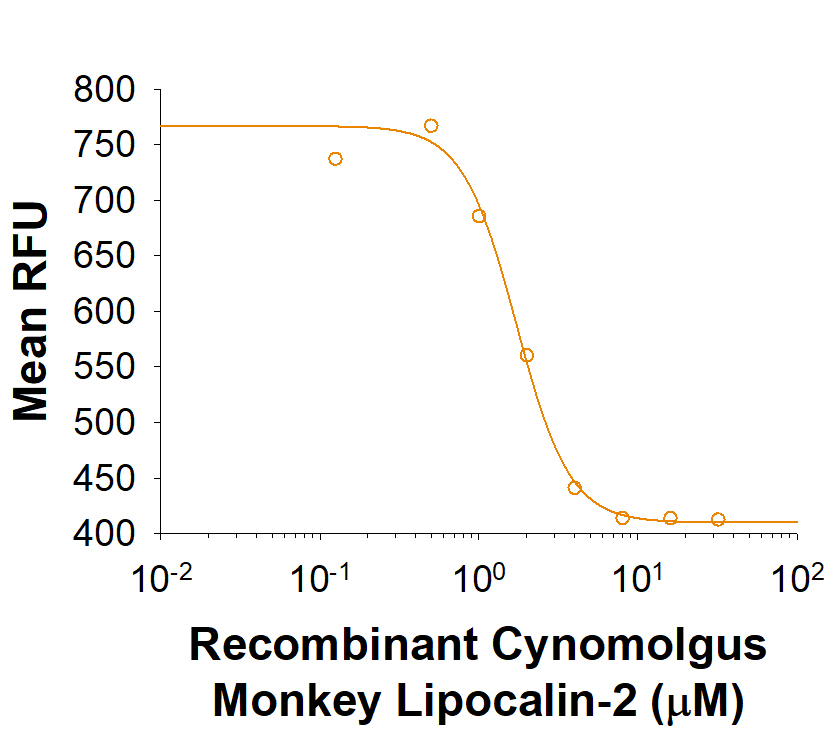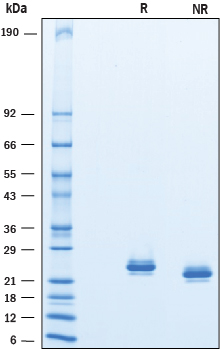Recombinant Cynomolgus Lipocalin-2/NGAL His-tag Protein, CF
Recombinant Cynomolgus Lipocalin-2/NGAL His-tag Protein, CF Summary
Product Specifications
Gln21-Gly198
with C-terminal 6-His tag
Analysis
Product Datasheets
Carrier Free
CF stands for Carrier Free (CF). We typically add Bovine Serum Albumin (BSA) as a carrier protein to our recombinant proteins. Adding a carrier protein enhances protein stability, increases shelf-life, and allows the recombinant protein to be stored at a more dilute concentration. The carrier free version does not contain BSA.
In general, we advise purchasing the recombinant protein with BSA for use in cell or tissue culture, or as an ELISA standard. In contrast, the carrier free protein is recommended for applications, in which the presence of BSA could interfere.
2357-LC
| Formulation | Supplied as a 0.2 μm filtered solution in MES and NaCl. |
| Shipping | The product is shipped with polar packs. Upon receipt, store it immediately at the temperature recommended below. |
| Stability & Storage: | Use a manual defrost freezer and avoid repeated freeze-thaw cycles.
|
Assay Procedure
- Assay Buffer: 50 mM Tris, 10 mM CaCl2, 150 mM NaCl, pH 7.5 (TCN)
- Ligand Buffer: 0.1 M Tris, pH 8.0
- Recombinant Cynomolgus Monkey Lipocalin‑2/NGAL His-tag (cynoLipocalin-2) (Catalog # 2357-LC)
- Iron III (Fe3+) (Sigma, Catalog # 16596)
- 2,3,Dihydroxybenzoic Acid (DHBA) (Sigma, Catalog # 126209)
- F16 Black Maxisorp Plate (Nunc, Catalog # 475515)
- Fluorescent Plate Reader (Model: SpectraMax Gemini EM by Molecular Devices) or equivalent
- Prepare a curve of Fe3+ in deionized water with the following serial dilutions: 640, 320, 160, 80, 40, 20, 10, 5, and 2.5 µM.
- Prepare 1 mM DHBA in Ligand Buffer from powder stock.
- Combine equal volumes of the Fe3+ curve with 1 mM DHBA. Include a control containing 1 mM DHBA and deionized water.
- Incubate at room temperature for 10 minutes. A curve of the metal ligand complex of Fe(DHBA)3 is formed.
- After incubation, perform 5 fold dilutions to the curve using Assay Buffer.
- Dilute rcynoLipocalin-2 (MW: 21200 Da) to 4 µM in Assay Buffer.
- In the plate, load 50 µL of the diluted Fe(DHBA)3 complex curve and 50 µL of 4 µM rcynoLipocalin-2.
- Incubate at room temperature for 30 minutes.
- Read at excitation and emission wavelengths of 280 nm and 340 nm, respectively in endpoint mode.
- Plot a 4-parameter curve of Fe(DHBA)3 Concentration (x-axis) versus RFUs ( gamma -axis), and calculate a BC50 from the curve.
- Fe(DHBA)3 Complex Curve: 0.125, 0.25, 0.5, 1.0, 2.0, 4.0, 8.0, 16, and 32 µM
- rcynoLipocalin-2: 2 µM
Scientific Data
 View Larger
View Larger
Recombinant Cynomolgus Monkey Lipocalin-2 (Catalog # 2357-LC) is measured by its ability to bind Iron(III) dihydroxybenzoic acid.
 View Larger
View Larger
2 μg/lane of Recombinant Cynomolgus Monkey Lipocalin‑2/NGAL was resolved with SDS-PAGE under reducing (R) and non-reducing (NR) conditions and visualized by Coomassie® Blue staining, showing a primary band at 24 kDa under reducing conditions.
Reconstitution Calculator
Background: Lipocalin-2/NGAL
Lipocalin-2 (LCN-2) is a member of the lipocalin family. These proteins share a highly conserved fold with an eight-stranded antiparallel beta barrel and act as small molecule transporters (1). Lipocalin-2, also known as Neutrophil Gelatinase-Associated Lipocalin (NGAL), was originally identified as a component of neutrophil granules (2). It is a 25 kDa protein existing in monomeric and homo- and heterodimeric forms, the latter as a dimer with neutrophil gelatinases (MMP-9) (2). Studies indicate that Lipocalin-2 binds iron through association with dihydroxybenzoic acid (DHBA), a sidropore similar to bacterial enterobactin (3). Its expression has been observed in most tissues normally exposed to microorganisms and is induced in epithelial cells during inflammation (2). Secretion of Lipocalin-2 in immune cells increases by stimulation of Toll-like receptor as an acute phase response to infection. As a result, it acts as a potent bacteriostatic reagent by sequestering iron (4). Lipocalin-2 has been implicated in a variety of processes including cell differentiation, tumorigenesis, and apoptosis (5-8). Lipocalin-2 can alter the invasive and metastatic behavior of Ras-transformed breast cancer cells via effects on the Ras-MAPK signaling pathway (9). In the kidney, Lipocalin-2 mediated iron trafficking may be involved in renal injury, and it has been implicated as a marker for early kidney failure (10-12).
- Flower, D. R. et al. (1994) FEBS Lett. 354:7.
- Kjeldsen L. et al. (2000) Biochim. Biophys. Acta. 1482:272.
- Goetz, D. H. et al. (2002) Mol. Cell 10:1033.
- Flo, T. H. et al. (2004) Nature 432:917.
- Yang, M. B. et al. (2002) Mol. Cell. 10:1045.
- Ferreira, A. C. et al. (2018) Neurosci. BioBehav. Rev. 95:73.
- Devireddy, L. R. et al. (2001) Science 293:829.
- Jung, M. et al. (2017) Front. Immunol. 8:1171.
- Hanai, J. et al. (2005) J. Biol. Chem. 280:13641.
- Mori, K. et al. (2005) J. Clin. Invest. 115:610.
- Sun, W. Y. et al. (2018) JCI Insight. 3:120196.
- Zhou, F. et al. (2016) Eur. J. Cardiothorac. Surg. 49:746.
Citation for Recombinant Cynomolgus Lipocalin-2/NGAL His-tag Protein, CF
R&D Systems personnel manually curate a database that contains references using R&D Systems products. The data collected includes not only links to publications in PubMed, but also provides information about sample types, species, and experimental conditions.
1 Citation: Showing 1 - 1
-
Machine learning guided aptamer refinement and discovery
Authors: A Bashir, Q Yang, J Wang, S Hoyer, W Chou, C McLean, G Davis, Q Gong, Z Armstrong, J Jang, H Kang, A Pawlosky, A Scott, GE Dahl, M Berndl, M Dimon, BS Ferguson
Nature Communications, 2021-04-22;12(1):2366.
Species: N/A
Sample Types: Complex Sample Type
Applications: Flow Cytometry
FAQs
No product specific FAQs exist for this product, however you may
View all Proteins and Enzyme FAQsReviews for Recombinant Cynomolgus Lipocalin-2/NGAL His-tag Protein, CF
There are currently no reviews for this product. Be the first to review Recombinant Cynomolgus Lipocalin-2/NGAL His-tag Protein, CF and earn rewards!
Have you used Recombinant Cynomolgus Lipocalin-2/NGAL His-tag Protein, CF?
Submit a review and receive an Amazon gift card.
$25/€18/£15/$25CAN/¥75 Yuan/¥2500 Yen for a review with an image
$10/€7/£6/$10 CAD/¥70 Yuan/¥1110 Yen for a review without an image
